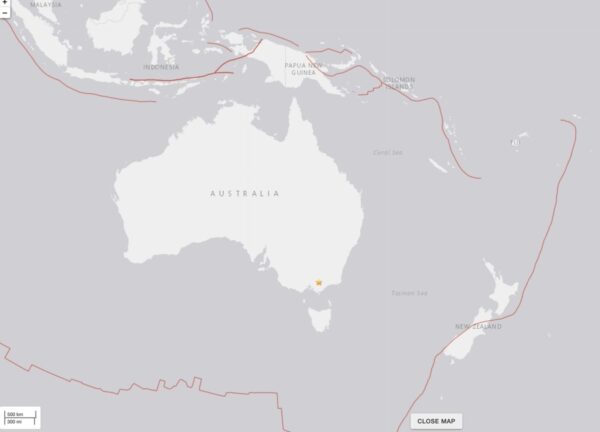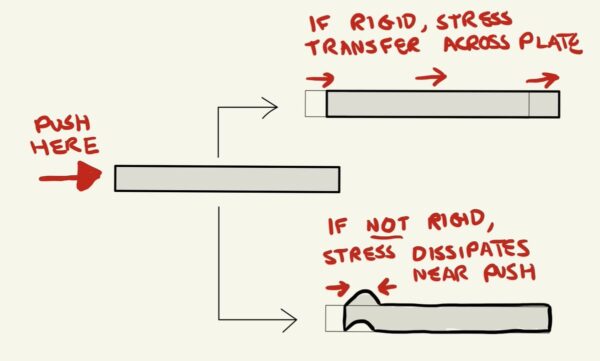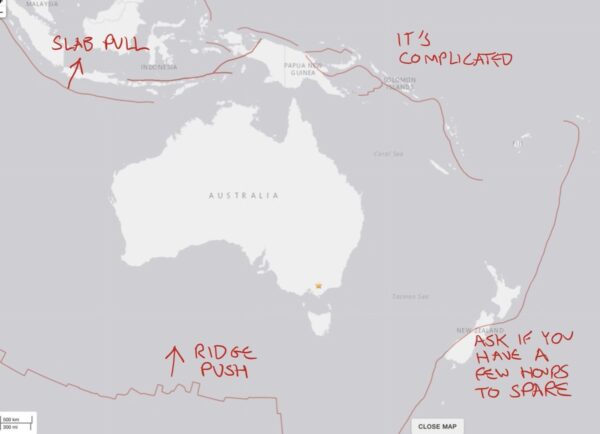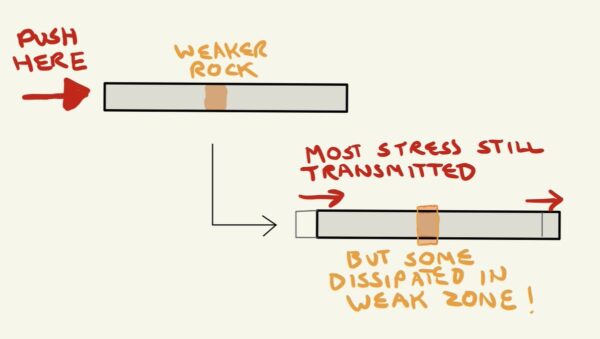There’s already a lot of good info out there about this week’s magnitude 5.9 earthquake near Melbourne, Australia. I wanted to dig a little more into the broader reasons you can get earthquakes like this in places you might not expect.
The Melbourne quake is a long way from any recognizable plate boundary – the closest one is more than 1000 km away. It is what we can an intraplate earthquake – one that occurs within a plate interior. This is in contrast to the interplate earthquakes that occur at plate boundaries*.

To understand why we can get earthquakes inside a tectonic plate, you need to understand why we get earthquakes anywhere. To produce an earthquake, you need:
- differential motion between two bits of the crust;
- a fault that can accommodate that differential motion by motion along its surface (and has some friction so that the motion is not continuous)
At plate boundaries, the source of differential motion is obvious: you’ve got two chunks of crust moving in different directions. And at its most simple, a plate boundary is a planar break in the lithosphere. Add a bit of friction, and voilà: periodic interplate earthquakes accommodating that motion.

So what’s going on inside plates? The key point is that plates are moving because they are under stress. They are being pushed and pulled at their edges, and are strong enough internally that they translate rather than deform internally in response (in technical terms, they are a stress guide).

For example, the Australian plate is being pushed by a mid-ocean ridge to the south and pulled by a subduction zone to the north, so it is moving north.

So the rocks that make up the plate are under stress due to these forces. But particularly on continents, the rocks which make up the plate are different depending on where you are, and sometimes bear billions of years’ worth of tectonic scars (pretty much everywhere has been a plate boundary at least once). In other words, there are variations in the strength of the plate.
And if the strength of the plate changes, then so does its response to stress – the strain. Weak bits will deform more than strong bits.

There’s your differential motion. And if the point of weakness is an old fault, then voilà – an intraplate earthquake, such as the one we just saw in Australia. Or the New Madrid earthquakes of 1811–12. Or the 2011 Virginia earthquake. Or that one in North Carolina last year.
The differential motions we’re talking about here are very small compared to those that occur across plate boundaries, so it takes much, much longer to build up enough elastic strain on an intraplate fault to generate a significant earthquake. So they are very good at taking us by surprise – because there have been no large earthquakes in the relatively short length of time we’ve been paying any attention to such things, we may not have even considered the risk of an earthquake happening there. When buildings and populations are totally unprepared, even a relatively smallish intraplate earthquake can have an outsize effect.
[this post was collated from this Twitter thread]
*If you’re thinking “interplate” and “intraplate” sound very similar and easily confused – yep. I have learnt to my cost that they should be annunciated v-e-r-y s-l-o-w-l-y in lectures.



Nice plan for content warnings on Mastodon and the Fediverse. Now you need a Mastodon/Fediverse button on this blog.